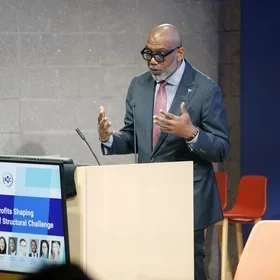By Dr. Steven Cohen, Senior Vice Dean, School of Professional Studies; Professor in the Practice of Public Affairs, School of International and Public Affairs
COP-28 is now a memory, and what I often call the “Annual Climate Trade Show” has ended along with its typical manufactured controversies and silly symbolic battles. My favorite this year was “should fossil fuels be phased out or phased down?” OPEC fought the effort to end the use of fossil fuels while other nations wanted to announce their demise. I have news for the negotiators—when the time comes, fossil fuels will be displaced in the market by lower-cost, more reliable, and cleaner forms of renewable energy. The language in COP-28’s final agreement is largely irrelevant.
While these conferences have value because they focus attention on climate change, they are problematic because they raise expectations that international agreements can actually solve the climate problem. The logic behind a global treaty is that climate change is a global problem that can only be addressed through global action by governments. The governments of sovereign nation-states act in their own self-interest, and—due to varied levels of economic development and the importance of economic growth to the survival of political regimes—they view the climate crisis with very different perspectives. For that reason, global climate agreements tend to be vague, unenforceable, and ineffective. Governments have an important role to play in addressing climate change, but their role is limited to actions they take on their own where they actually have authority: within their nation-states.
The COP-28 conference attracted about 84,000 participants, including many fossil fuel company lobbyists and executives who tried to influence the dialogue of the conference and the language of the final agreement. While COP-28 may have been an exercise in futility, lobbyists know a good party when they see one. Ask yourself this: if the other 27 COPs didn’t eliminate climate change, why would the 28th finally get it done? The short answer is that the world economy is hooked on energy, and, for the moment, that means we are addicted to fossil fuels. Renewables are on the rise, but so is total energy use. No number of conferences can disguise that fact of economic life. I know that these gatherings have educational and media value, but they are not important arenas of policymaking. Pretending that they have operational meaning is delusional. Their role is to influence and educate people. That is an important role, but let’s not confuse it with policymaking and policy implementation.
So, since we won’t see a meaningful global climate treaty, how will we address global warming? Fortunately, we don’t need to depend on a world government or global agreement to make progress. It turns out that extreme weather exacerbated by climate change has transformed the climate predictions of the 1990s into 2023’s environmental reality. The computer models predicting our warming future turned out to be correct. This, in turn, has made investors and insurance companies wary of environmental risk. Publicly traded corporations will soon be required to disclose their carbon emissions, and once these carbon measures are public and comparable, companies will be under pressure to reduce their emissions and adapt to environmental risk. Moreover, nations like the United States are investing in green infrastructure and enacting national, state, and local policies to accelerate the transition to renewable energy. These trends are not universal, and it’s often a matter of two steps forward and one step back, but the transition to a renewable resource-based economy has begun, and its momentum will only grow with the passage of time. Environmental sustainability has entered corporate culture and is being seen as “best management practice.” A warming and more polluted planet turns out to be bad for business. Young people entering the business world understand this and are transforming corporations from the inside. This change in corporate culture is well underway and not influenced by politics or ideology. It is a response to objective environmental conditions that young people have known their entire lives.
The technologies of renewable energy and batteries are advancing rapidly and, in many situations, already provide a lower cost and highly reliable replacement for fossil fuels. Like Moore’s law in computing, the price and reliability of renewable energy will continue to improve, as will the price and efficiency of electric vehicles. Fossil fuels still need to be extracted, shipped, and burned—with each step causing pollution and costing money. But the fossil fuel business is doomed. Renewable energy will eventually drive fossil fuels from the market. The current electric energy grid is old, inefficient, and vulnerable. A rebuilt one based on computer-controlled decentralized microgrids and renewable energy will provide lower-cost and more reliable electricity. Our homes and motor vehicles will gradually go electric, and carbon emissions will be reduced as an indirect impact of our modernized and distributed system of electricity generation. This change will take time, and during that time, our planet will get warmer.
Climate change is the sustainability problem that generates the most attention, but it is not our only environmental problem. It is also far less complicated than problems related to toxics, biodiversity, and infectious diseases. Fortunately, we are also seeing human ingenuity and new technologies applied to these problems as well. Turning to agriculture, we see growing use of robotics, artificial intelligence, drones, and satellite data, allowing farmers to target their use of fertilizer, pesticides, herbicides, and water to reduce costs along with climate and toxic pollution from farms. We will someday recycle and mine our waste stream for resources with automation and artificial intelligence, reducing the costs of waste disposal by turning garbage into resources like fertilizer and the metals used in manufacturing. The circular economy of the future, where recycling is built into production and consumption, will replace the current linear economy, where we manufacture, use, and dump everything we produce. It won’t happen because of an agreement at “COP45” but because the price of land for dumping and the price of mining the planet will drive the economics of waste management and resource acquisition.
It will be human ingenuity, creating new technologies and new business models, that will ultimately address the climate crisis and the crisis of global environmental sustainability. The annual gathering of the climate industry will continue to be a place where new plans and policies are proposed, but the large-scale policy pronouncements of those gatherings are far less important than the ideas exchanged and relationships built. Eventually, the excitement of the climate conferences will recede along with the existential threat of climate change. But new technologies not only solve old problems but create new problems as well. There will be other existential environmental crises, and the global conference industry need not worry, there will be plenty of global conferences. In a world that too often adopts new technologies before we understand their side effects, you can be sure that new global problems will emerge to replace climate change. COVID-19 gave us a glimpse of what might come next. But the rapid development of COVID-19 vaccines provided a hint of how the problems caused by technology will largely be addressed by the development of new technologies. Government will partner with the private sector to support the transition to the new economy. Government’s role will include regulation along with funding basic research, infrastructure support, and tax incentives. It will not include the implementation of mandates from global agreements.
Views and opinions expressed here are those of the authors, and do not necessarily reflect the official position of Columbia School of Professional Studies or Columbia University.
About the Program
The Columbia University M.S. in Sustainability Management program offered by the School of Professional Studies in partnership with the Climate School provides students cutting-edge policy and management tools they can use to help public and private organizations and governments address environmental impacts and risks, pollution control, and remediation to achieve sustainability. The program is customized for working professionals and is offered as both a full- and part-time course of study.



